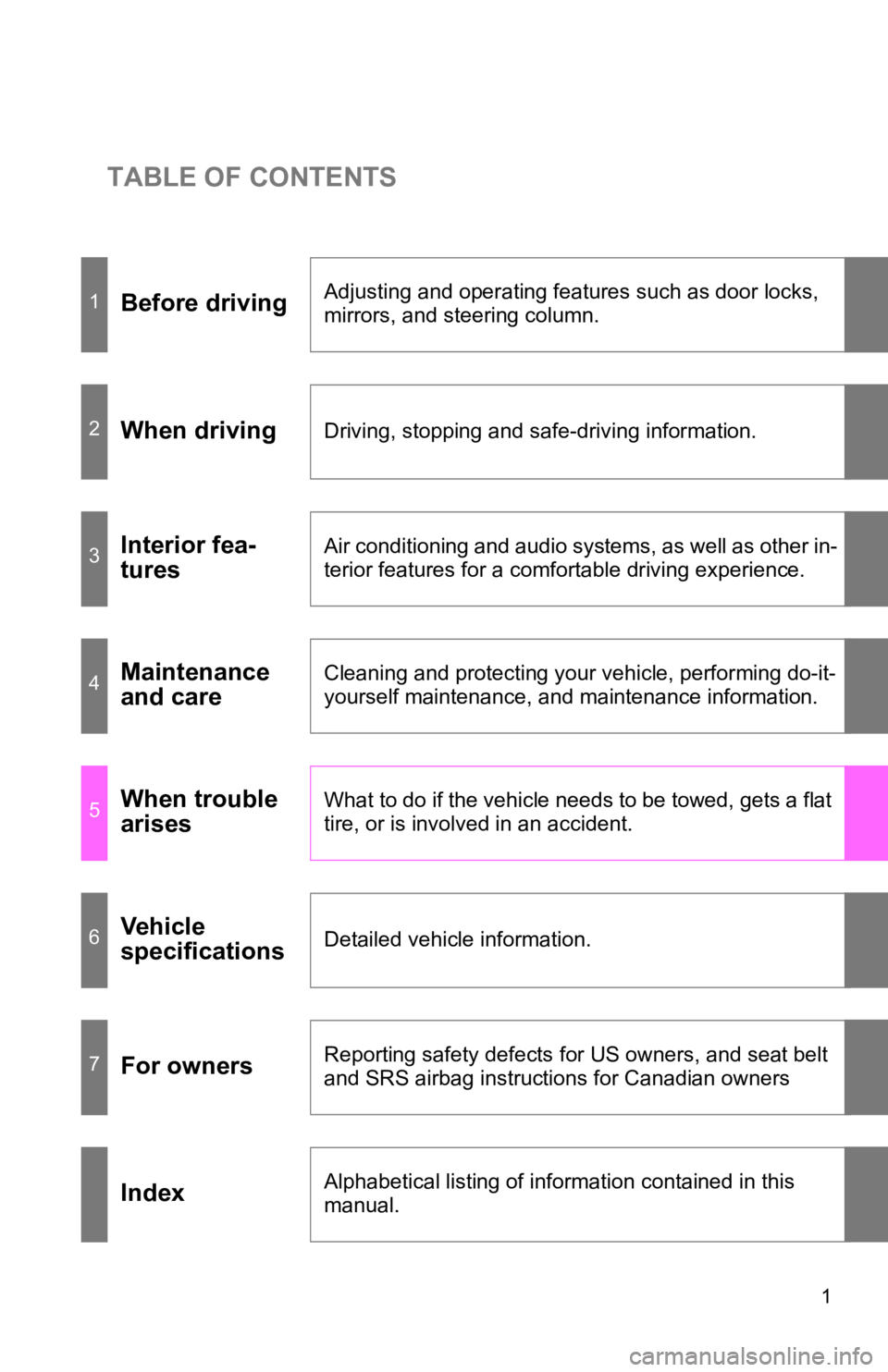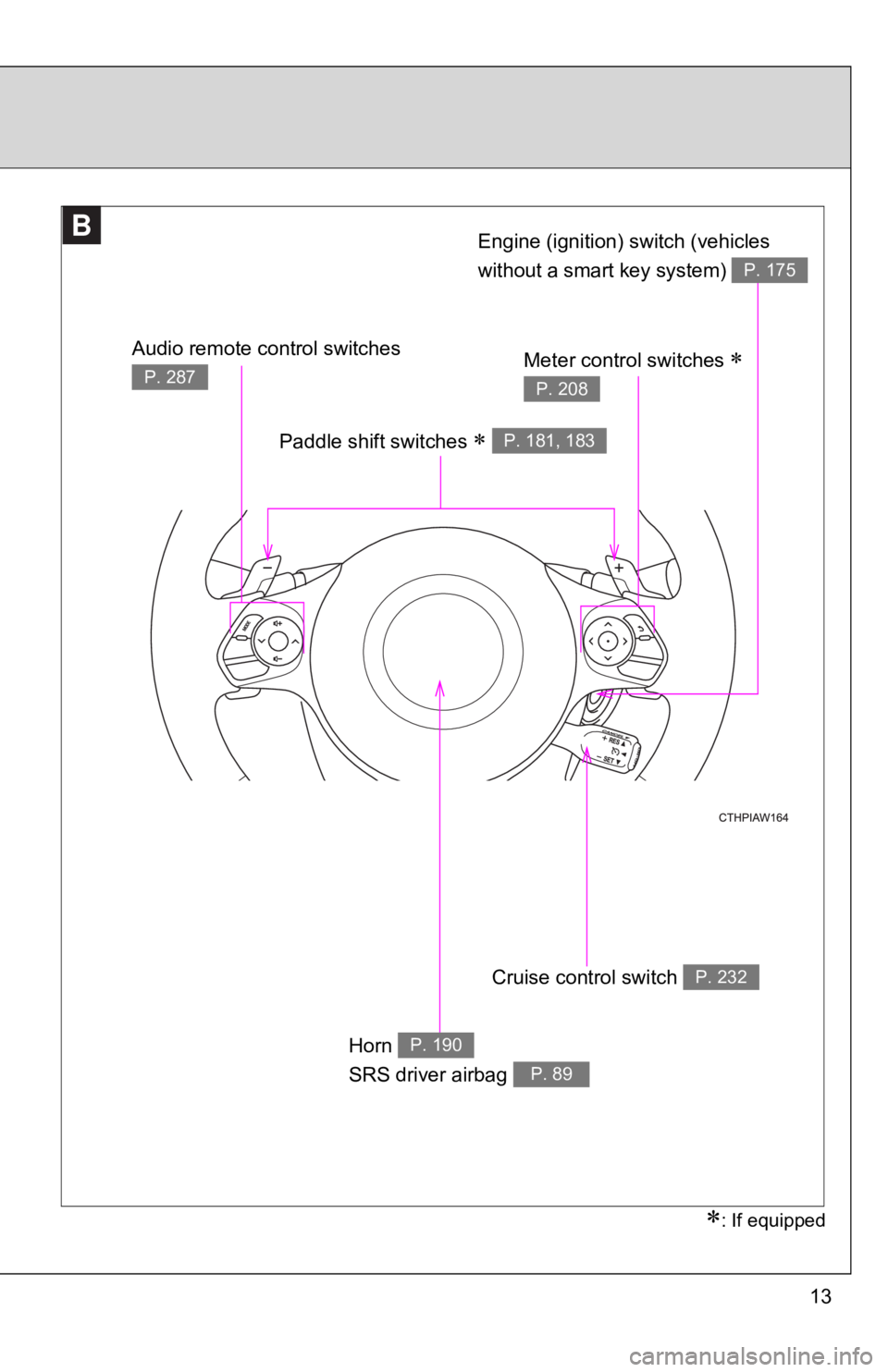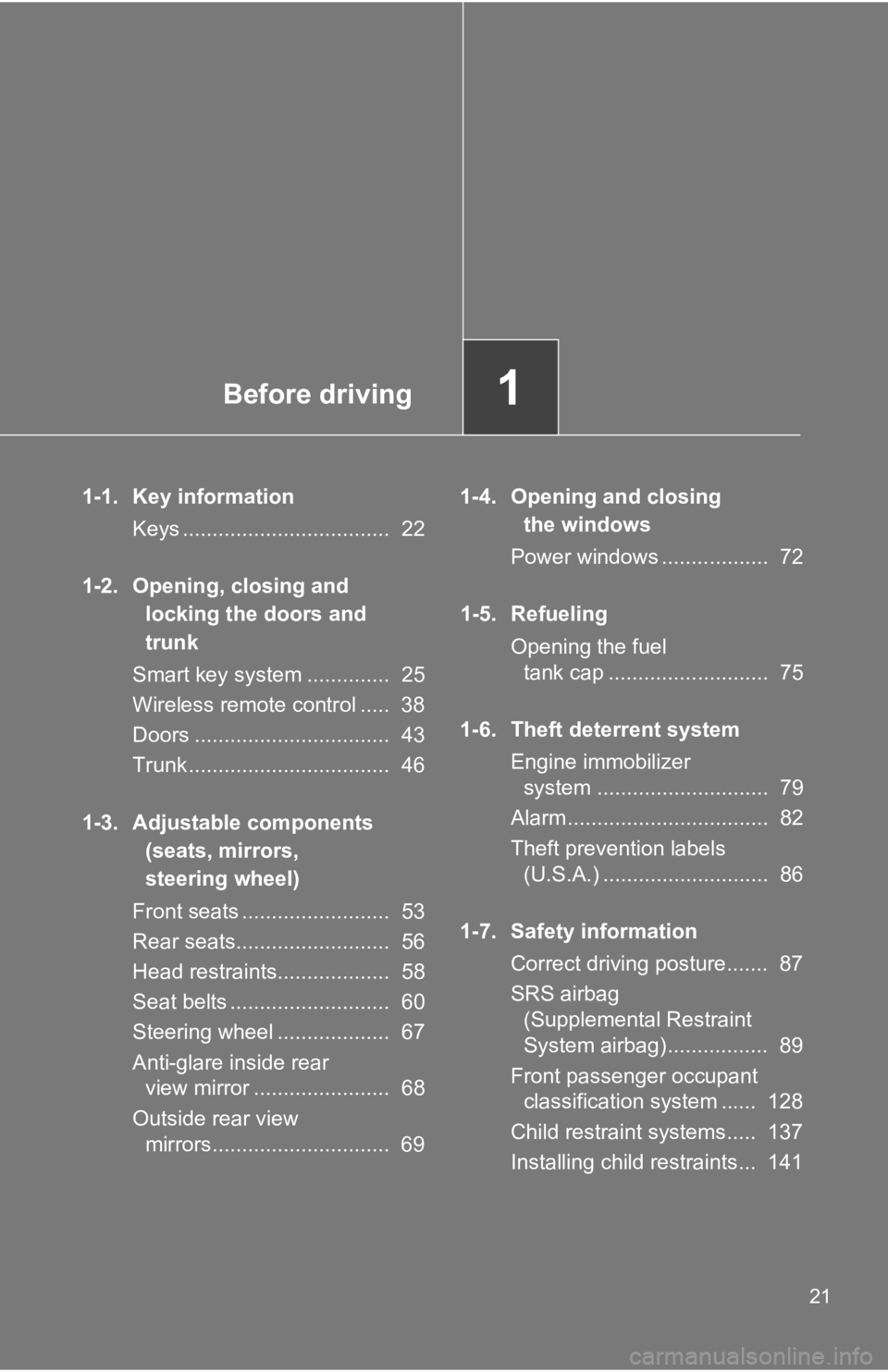airbag TOYOTA 86 2019 Owners Manual
[x] Cancel search | Manufacturer: TOYOTA, Model Year: 2019, Model line: 86, Model: TOYOTA 86 2019Pages: 532, PDF Size: 6.89 MB
Page 1 of 532

TABLE OF CONTENTS
11
Before driving Adjusting and operating features such as door locks,
mirrors, and steering column.
2
When driving Driving, stopping and safe-driving information.
3
Interior fea-
tures Air conditioning and audio systems, as well as other in-
terior features for a comfortable driving experience.
4
Maintenance
and care Cleaning and protecting your vehicle, performing do-it-
yourself maintenance, and maintenance information.
5
When trouble
arises What to do if the vehicle needs to be towed, gets a flat
tire, or is involved in an accident.
6
Vehicle
specifications Detailed vehicle information.
7
For owners Reporting safety defects for US owners, and seat belt
and SRS airbag instructions for Canadian owners
Index Alphabetical listing of information contained in this
manual.
Page 2 of 532

TABLE OF CONTENTS Index
21-1. Key information
Keys ..................................... 22
1-2. Opening, closing and
locking the doors and
trunk
Smart key system................. 25
Wireless remote control ....... 38
Doors.................................... 43
Trunk .................................... 46
1-3. Adjustable components
(seats, mirrors,
steering wheel)
Front seats ........................... 53
Rear seats ............................ 56
Head restraints ..................... 58
Seat belts ............................. 60
Steering wheel ..................... 67
Anti-glare inside rear
view mirror.......................... 68
Outside rear view mirrors ..... 69
1-4. Opening and closing
the windows
Power windows .................... 72
1-5. Refueling
Opening the fuel tank cap .... 75 1-6. Theft deterrent system
Engine immobilizer
system ................................ 79
Alarm .................................... 82
Theft prevention labels
(U.S.A.)............................... 86
1-7. Safety information
Correct driving posture ......... 87
SRS airbag
(Supplemental Restraint
System airbag) ................... 89
Front passenger occupant
classification system ......... 128
Child restraint systems ....... 137
Installing child restraints ..... 141
2-1. Driving procedures
Driving the vehicle .............. 152
Engine (ignition) switch
(vehicles with a smart
key system) ...................... 166
Engine (ignition) switch
(vehicles without a
smart key system) ............ 175
Automatic transmission ...... 178
Manual Transmission ......... 185
Turn signal lever ................. 188
Parking brake ..................... 189
Horn .................................... 1901
Before driving
2
When driving
Page 5 of 532

1
2
3
4
5
6
7
55-2. Steps to take in an
emergency
If a warning light turns on
or a warning buzzer
sounds... ........................... 395
If a warning message is
displayed........................... 407
If you have a flat tire............ 424
If the engine will not start .... 435
If the shift lever cannot be
shifted from P.................... 438
If you lose your keys ........... 439
If the electronic key does
not operate properly.......... 440
If the battery is
discharged ........................ 444
If your vehicle overheats ..... 449
If the vehicle becomes
stuck ................................. 452
If your vehicle has to be
stopped in an
emergency ........................ 454 6-1. Specifications
Maintenance data
(fuel, oil level, etc.) ........... 458
Fuel information.................. 470
Tire information .................. 474
6-2. Customization
Customizable features........ 487
Reporting safety defects
for U.S. owners ................ 492
Seat belt instructions
for Canadian owners
(in French) ........................ 493
SRS airbag instructions
for Canadian owners
(in French) ........................ 496
Abbreviation list ........................ 520
Alphabetical index .................... 521
What to do if... .......................... 529 6
Vehicle specifications
7
For owners
Index
Page 8 of 532

8Pictorial index Interior
Power outlet P. 299Head restraints P. 58
Seat belts P. 60
SRS front passenger
airbag P. 89
Cup holders
Console tray P. 294
P. 294
SRS side airbags P. 89
Front seats P. 53
Glove box P. 292SRS curtain shield
airbags P. 89
Child restraint
anchor brackets P. 141
Page 13 of 532

13BB Paddle shift switches
P. 181, 183
Cruise control switch P. 232
Horn
SRS driver airbag P. 190
P. 89
: If equippedAudio remote control switches P. 287
Meter control switches
P. 208Engine (ignition) switch (vehicles
without a smart key system) P. 175
Page 16 of 532

16 Installation of a mobile two-way radio system The installation of a mobile two-way radio system in your vehicle could affect
electronic systems such as:
● Multiport fuel injection system/sequential multiport fuel injec tion system
● Cruise control system
● Anti-lock brake system
● SRS airbag system
● Seat belt pretensioner system
Be sure to check with your Toyota dealer for precautionary meas ures or spe-
cial instructions regarding installation of a mobile two-way radio system.
Page 19 of 532

19Scrapping of your Toyota The SRS airbag and seat belt pretensioner devices in your Toyot a contain
explosive chemicals. If the vehicle is scrapped with the airbags and seat belt
pretensioners left as they are, this may cause an accident such as fire. Be
sure to have the systems of the SRS airbag and seat belt preten sioner
removed and disposed of by a qualified service shop or by your To y o t a
dealer before you scrap your vehicle.
Perchlorate Material Special handling may apply, See www.dtsc.ca.gov/hazardouswaste/ perchlorate.
Your vehicle has components that may contain perchlorate. These
components may include airbag, seat belt pretensioners, and wir eless
remote control batteries.
WARNING■ General precautions while driving
Driving under the influence: Never drive your vehicle when unde r the influ-
ence of alcohol or drugs that have impaired your ability to ope rate your vehi-
cle. Alcohol and certain drugs delay reaction time, impair judg ment and
reduce coordination, which could lead to an accident that could result in
death or serious injury.
Defensive driving: Always drive defensively. Anticipate mistake s that other
drivers or pedestrians might make and be ready to avoid acciden ts.
Driver distraction: Always give your full attention to driving. Anything that dis-
tracts the driver, such as adjusting controls, talking on a cel lular phone or
reading can result in a collision with resulting death or serio us injury to you,
your occupants or others.
■ General precaution regarding children’s safety
Never leave children unattended in the vehicle, and never allow children to
have or use the key.
Children may be able to start the vehicle or shift the vehicle into neutral.
There is also a danger that children may injure themselves by p laying with
the windows or other features of the vehicle. In addition, heat build-up or
extremely cold temperatures inside the vehicle can be fatal to children.
Page 21 of 532

Before driving
1
211-1. Key information
Keys ................................... 22
1-2. Opening, closing and
locking the doors and
trunk
Smart key system .............. 25
Wireless remote control ..... 38
Doors ................................. 43
Trunk .................................. 46
1-3. Adjustable components
(seats, mirrors,
steering wheel)
Front seats ......................... 53
Rear seats.......................... 56
Head restraints................... 58
Seat belts ........................... 60
Steering wheel ................... 67
Anti-glare inside rear
view mirror ....................... 68
Outside rear view
mirrors.............................. 69 1-4. Opening and closing
the windows
Power windows .................. 72
1-5. Refueling
Opening the fuel
tank cap ........................... 75
1-6. Theft deterrent system
Engine immobilizer
system ............................. 79
Alarm.................................. 82
Theft prevention labels
(U.S.A.) ............................ 86
1-7. Safety information
Correct driving posture....... 87
SRS airbag
(Supplemental Restraint
System airbag)................. 89
Front passenger occupant
classification system ...... 128
Child restraint systems..... 137
Installing child restraints... 141
Page 62 of 532

621-3. Adjustable components (s eats, mirrors, steering wheel)
■ Emergency locking retractor (ELR)
The retractor will lock the belt during a sudden stop or on imp act. It may also
lock if you lean forward too quickly. A slow, easy motion will allow the belt to
extend so that you can move around fully.
■ Automatic locking retractor (ALR)
When a passenger's shoulder belt is completely extended and the n
retracted even slightly, the belt is locked in that position and cannot be
extended. This feature is used to hold the child restraint syst em (CRS) firmly.
To free the belt again, fully retract the belt and then pull th e belt out once
more. ( P. 141)
■ Child seat belt usage
The seat belts of your vehicle are principally designed for persons of adult
size.
● Use a child restraint system appropriate for the child, until the child
becomes large enough to properly w ear the vehicle's seat belt.
( P. 137)
● When the child becomes large enough to properly wear the vehicl e's seat
belt, follow the instructions on P. 60 regarding seat belt usag e.
■ Seat belt pretensioners
● Seatbelt pretensioners are not designed to activate in a rear i mpact or
minor frontal or side impact.
● The following four components operate simultaneously when the v ehicle
is involved in a rollover accident.
• Seat belt pretensioner for driver
• Seat belt pretensioner for front passenger
• SRS curtain shield airbag for driver’s seat side
• SRS curtain shield airbag for front passenger’s seat side
Page 63 of 532

631-3. Adjustable components (s eats, mirrors, steering wheel)
1
Before driving ● The following four components operate simultaneously when the v ehicle
is subjected to a severe frontal collision.
• Seat belt pretensioner for driver
• Seat belt pretensioner for front passenger
• SRS front airbag for driver
• SRS front airbag for front passenger*
*: This does not operate while the occupant classification syste m deter-
mines to deactivate the airbag operation. For details, refer to “Front pas-
senger’s SRS frontal airbag” ( P. 97)
● The following two components operate simultaneously when the ve hicle
is subjected to a severe collision on the driver’s seat side of the vehicle.
• Seat belt pretensioner for driver
• Side airbag for driver
● The following two components operate simultaneously when the ve hicle
is subjected to a severe collision on the front passenger’s seat side of the
vehicle.
• Seat belt pretensioner for front passenger
• Side airbag for front passenger
● Pretensioners are designed to function on a one-time-only basis . In the
event that a pretensioner is activated, both the driver’s and f ront passen-
ger’s seat belt retractor assemblies must be replaced only by T oyota
dealer. When replacing seat belt retractor assemblies for the f ront seat-
ing positions, use only genuine Toyota parts equipped with a fo rce limiter.
● If either front seat belt does not retract or cannot be pulled out due to a
malfunction or activation of the pretensioner, contact your Toyota dealer
as soon as possible.
● If the front seat belt retractor assembly or surrounding area h as been
damaged, contact your Toyota dealer as soon as possible.
● When you sell your vehicle, we urge you to explain to the buyer that it
has seat belt pretensioners by alerting the buyer to the conten ts of this
section.
■ Replacing the belt after the pr etensioner has been activated
If the vehicle is involved in multiple collisions, the pretensi oner will activate
for the first collision, but will not activate for the second or subsequent colli-
sions.